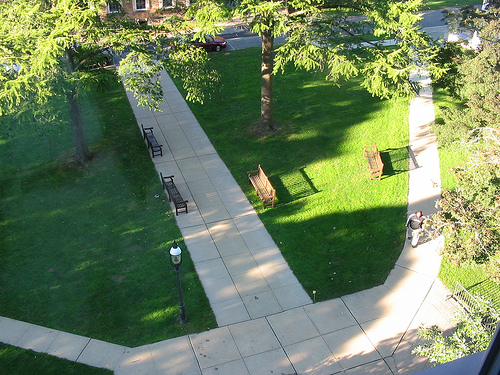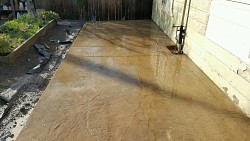How to Replace Grass

Photo of a lush lawn by Accretion Disc/Flickr.
The first home I owned was a tall skinny townhouse with a long skinny back yard. In that itsy bitsy footprint in the middle of the city, we fit two adults, one wee offspring, two big dogs, and two very unruly hens. Between the dogs and the chickens (and eventually, the little boy), that poor patch of yard took quite the beating.
So every year in early spring, I’d go about reseeding. Spring is a time for renewal, and that meant learning how to replace grass. At first I did it the cheap and easy way – meaning, I threw grass seeds at the bare bits and hoped they stuck. Well, that’s not entirely true. Sometimes I even made sure to keep the chickens and dogs off the area for a few weeks! Which definitely helped, by the way.
When it came time to let that house go, I looked out over that lumpy, patchy, pitiful excuse for a [very well loved] backyard and I thought “Throwing seeds just isn’t going to cut it this time.” Nope, this called figuring out how to replace the grass entirely.
There are two ways one can go about replacing lawn: either a proper reseeding, or buying pre-established sod. Sod is expensive and fickle, so I’d advise going the reseeding route, but doing it good and proper. Here’s the basic low-down on how to grow yourself an awesome, lush and lovely lawn:
1) Time it – you don’t want to begin in the middle of summer. Excessive heat and dryness will prevent your lawn from really taking root, so avoid a midsummer seeding.
2) Prep it – you need to remove everything. All that old lawn, all the weeds, all the dried stuff. Dig it out, poison it (NOT recommended, ew), or use a ground cover to starve it, which will take a few weeks. Whatever you choose, make sure that you get it all so you’re left with just the dirt. This part stinks. It’s hard work!
3) Till it – to turn over the soil, and also to add any conditioners or amendments you desire. Organic fertilizer goes here too. Mix it up good – this is important!
4) Level it – once it’s all mixed up and uniform. Use a standard rake to smooth the soil out so that it’s level all the way across, and make sure that the soil density is equally distributed (ie, no clay clumps in one area while there’s super aerated fluff in another).
5) Seed it – spread your grass seed of choice (which will depend on your climate) and use a rake to gently cover with the soil. You don’t have to cover every last seed. Also, don’t overdo it with the quantity. Too many seeds will actually cause less germination, so don’t go all super-seeder. The product bag itself will have instructions; follow those.
6) Mulch it (optional) and water it – but don’t over water it! You don’t need compost/mulch, but it’s a great idea and will help to retain moisture during germination. Water regularly through the germination and seedling phase, then less frequently as the grass takes hold and matures.
A note – keep off the grass as it’s growing! This goes for people, dogs, and chickens too if you’re an urban farmer like me. Try to keep the grass completely clear, to give it the very best start at life and help guarantee that it comes in thick and beautiful.
So there you go, how to replace grass for DIY better lawns and lovely backyards. Good luck!
An alternative, for the non-green-thumbed or the pressed-for-time, is to hire a professional to replace your lawn.
Sayward Rebhal writes for Networx.com.
Looking for a Pro? Call us (866) 441-6648

Landscaping Average Costs
Landscapers Experiences

Rock Landscaping Adds Curb Appeal To An Arizona Home

Tree Removal And Backyard Cleanup Make A New House Feel Like Home



